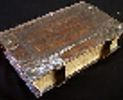
The traditional story according to legend is that Cecilia was a young patrician Roman, betrothed to a pagan, Valerian. She refused to consummate her marriage, she told him that an angel of God wished her to remain a virgin. He promised to respect this wish if he were allowed to see the angel. She replied that he would if he were baptized. On his return from baptism, he found Cecilia talking to the angel. She then converted his brother Tiburtius, who also saw the angel. Both men were martyred before she was. She distributed her possessions to the poor, which enraged the prefect Almachius, who ordered her to be burned. When the flames did not harm her, she was beheaded. Historical information about her martyrdom in the 3rd Century is unavailable.
Ironically, Valerian, Tibertius, and Maximus, another man who died with them, are known historical martyrs, but their association with Cecilia is unknown apart from the legend. However it may be truthful as her feast has been celebrated since the 4th Century.
There is a record of an early Roman Christian church founded by a lady of this name. The Church of St. Cecilia in Trastevere, in Rome, is reputedly built on the site of the house in which she lived. The original church was constructed in the 4th century. Cecilia's body was discovered incorrupt in 1599. She is known to be the first saint to be incorrupt (her body had not seen decay).
Cecelia's legend was very popular, and she became the patron saint of music from the 16th century. This seems to stem from the use of part of the legend of Cecilia as an antiphon, with a reference in it to organs playing at her wedding feast while Cecilia sang of her purity. That is the main reason for her commemoration today, giving as it does an occasion for celebrating music in worship.
 Welcome
Welcome Calendar
Calendar Today's Word
Today's Word Lauds
Lauds Terce
Terce Sext
Sext None
None Vespers
Vespers Compline
Compline Matins
Matins